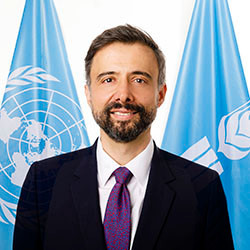World Economy's triple threat: averting food, energy and financial crises
IFAD Asset Request Portlet
ناشر الأصول
World Economy's triple threat: averting food, energy and financial crises
Town Hall event
من Alvaro Lario
The world has been battered over the past two years by a pandemic, by wildfires, floods and droughts linked to climate change; and by a widening food and energy crisis caused by war in the Ukraine.
As a global community we have struggled to respond, to protect economies, jobs, and most of all, people.
Our response has frankly been uneven, sometimes resolute and coordinated; other times not as much. But what is clear is that we have been at our best when we have worked together, in partnership, for the common good.
The G20 has the power to leverage that kind of partnership to literally change the world, to alter its course and steer us towards a sustainable future.
At IFAD, we have worked for more than four decades to finance agriculture and rural development and lift up the world’s poorest communities. Our eye has always been on the most vulnerable…. The poor and the hungry. The small-scale farmers who grow so much of our food—and who we need more than ever at times of crisis, when trade, transport and markets are disrupted.
The current spike in hunger, malnutrition and poverty is a warning to us all.
Of course we must act quickly to relieve current suffering and provide relief. And at the same time, we must invest in recovery and resilience for a more sustainable future.
Climate change is an existential threat, not tomorrow but now.
The crises we face today show how important it is to fully integrate emergency response and resilience building. Food systems are failing people, economies and planet. Hunger will increasingly fuel instability, conflict and migration unless we change how our food systems function and how they are financed.
The cost of transforming our food systems – from the farm through food processing, storage and transport is estimated at around US$300 to 400 billion a year until 2030.
That may sound like a lot. But it is less than 0.5% of global GDP.
It also much less than annual agricultural subsidies. And it is just a fraction of the $10 trillion market value of the world’s food systems.
Currently small farms receive less than 2 per cent of global climate finance though they produce a third of food.
So let’s not just talk about more investment, but the right investment. If resources are so scarce, why do we spend billions on the wrong things?
At a time when governments are struggling to stave off disaster, it may seem unrealistic to propose a new and visionary rethinking of how we approach development finance.
But if not now, when? Without long-term investment starting with the world’s poorest and most vulnerable, we will be scraping public coffers to address one disaster after another until there is nothing left.
And it’s not just about public finance. We need global partnerships that bring together governments, the private sector, development banks, UN agencies--and poor rural people themselves.
IFAD itself is an assembler of development finance targeted at the poorest people. Each dollar of core contributions to IFAD delivers $6 to $8 of investment through cofinancing and partnerships.
We will also continue to advocate strongly for more climate financing for poor and vulnerable farmers, because climate change is the biggest long-term threat to food systems and our planet. This will be the call to action we will bring to COP27.
We look forward to working with G20 members on innovative ways to close the financing gap.
It is absolutely possible to feed everyone in the world -- even at this time of multiple crises. Adaptive techniques and technology exist.
For example, we’ve seen how simply replanting native grasses along rivers and ponds can improve climate resilience by create breeding sites for fish and feed for domestic animals. With more fish to eat and better milk yields from livestock, communities can increase their income and improve nutrition.
Solar-powered water pumps can reduce the risks of rain-fed farming. Remote sensing can tell farmers how much fertilizer their crops need. Drones can show farmers which plants are in poor health.
But we will succeed only if we step up, scale up and face up to the underlying and systemic problems within our food systems.
So let’s think long-range, and from the ground up, and commit ourselves to work together.
Let’s start with food. Because food security is national security – and until we improve local food production and value chains, we will pay an even higher price in never-ending emergency assistance.
